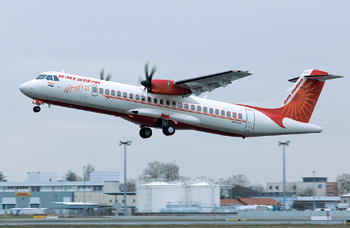INDIAN ARMED FORCES CHIEFS ON
OUR RELENTLESS AND FOCUSED PUBLISHING EFFORTS

SP Guide Publications puts forth a well compiled articulation of issues, pursuits and accomplishments of the Indian Army, over the years

I am confident that SP Guide Publications would continue to inform, inspire and influence.

My compliments to SP Guide Publications for informative and credible reportage on contemporary aerospace issues over the past six decades.
ATR Eyeing MRO in India
ATR which presently has a fleet of 36 in India is keen on getting into maintenance, repair and overhaul (MRO) and training as the fleet numbers gain substantial traction. A number of 60 plus ATR aircraft in the country makes sense for the company to further strengthen the aftermarket structure. The Head of Global Sales, John Moore gives R. Chandrakanth of SP’s Aviation the ATR scenario in India and beyond.

SP’s Aviation (SP’s): How has the India Aviation 2016 been so far? And what does the Indian market look like at this moment?
ATR: It has been extremely positive. There has been a stream of varied visitors, from prospective buyers to pilots to students wanting to know more about the best-selling turboprops in the world. We are ‘convinced’ of the Indian market which offers us enormous opportunities. With the draft National Civil Aviation Policy giving emphasis on regional connectivity, we hope to see lot more activity here and are making pitches accordingly.

SP’s: What is the current ATR fleet in India and what do you think it could be by 2020 when it will among the top three aviation markets?
ATR: As of today we have 36 ATRs in India and we expect it to grow fast as two factors are going to drive the upward trend – one is you have such a strong domestic passenger growth at 20 per cent and two the government policy which is focusing on regional connectivity and MRO. The government’s plan to develop small airports across the country will further drive passenger growth and these markets can be best served by a turboprop. ATR aircraft are comfortable, the standard of service is excellent, has latest features in avionics and it can land on any type of airfield. It is ideal for operators who are looking at smaller routes and routes which have lower yields. The ATR has low fuel burn and is most economical to operate. It gives operators the advantage of lowest trip cost compared to any regional jet or other turboprops.
SP’s: What is the current order book like?
ATR: The backlog across the world is 270 aircraft. This year we will deliver 95 aircraft and it is steadily climbing. It 2014 we delivered 83 and in 2015 it was 87. We are going to ramp up production as we expect our world market share (for both turboprop and regional jets) to go up from the present 40 per cent. About 30 per cent of the backlog is with the lessors and they do drive the market. We do facilitate prospective buyers with leasing solutions. I would like to mention here that Air India has just put out an RFP (request for proposal) for 10 small aircraft and we are responding to the RFP.
SP’s: The Indian authorities have made it clear to airframers that if they have to sell in India, they need to look at the package – to set up MRO here; training and simulator facility and facilitate in leasing options. Where does ATR stand on these three counts?
ATR: We are aware of it and as the fleet size grows in India we will build the structures, both MRO and training. Presently, we have Air Works and GMR supporting us in MRO and there is the Singapore hub too. We are looking at fleet size of over 60 to have these support structures in India.
SP’s: Could you tell us about some features of ATR that the operators should look at?
ATR: We are continuously improving our product. The ATR 600 is one such where a lot of improvement has gone on reducing noise levels; much larger baggage space; slim line passenger seating etc. It is a 78-seat version giving operators 6 to 8 seats more from the present version. The first customer of the aircraft is Cebu of Philippines.
SP’s: What about the aircraft’s performance on environmental aspects?
ATR: We have considerably worked on reducing noise levels. It has lower fuel burn than any other turboprop. The ATR is a ‘green aircraft’. We are working with Pratt & Whitney on biofuel applications but must tell you that environmentally we are one of the safest aircraft in the world.





